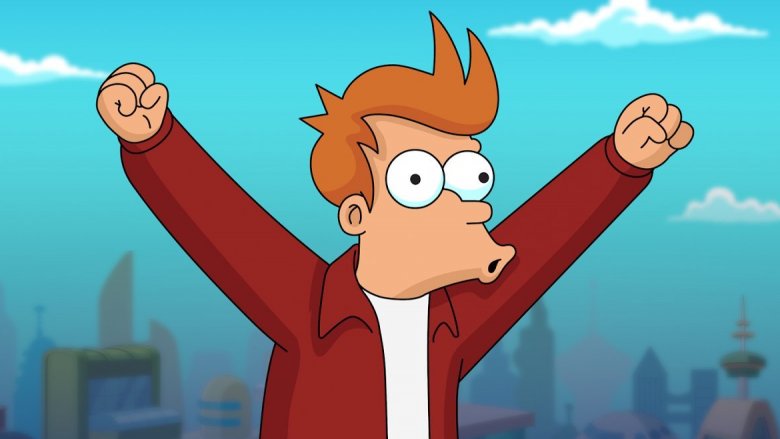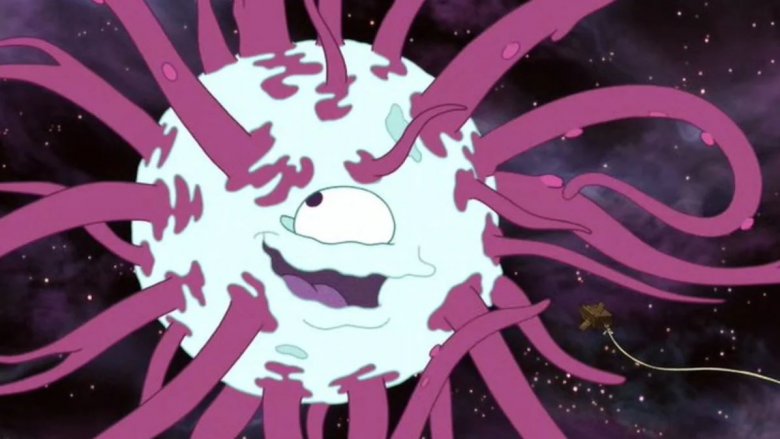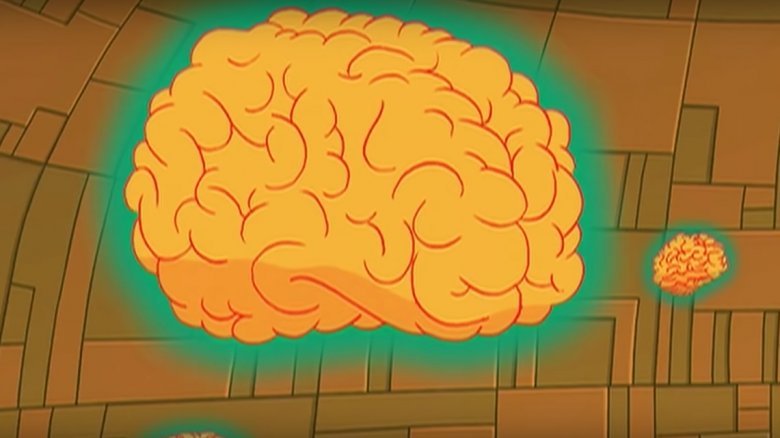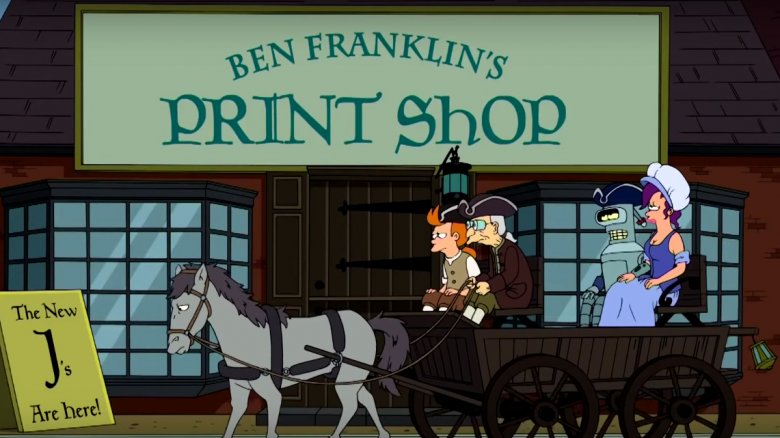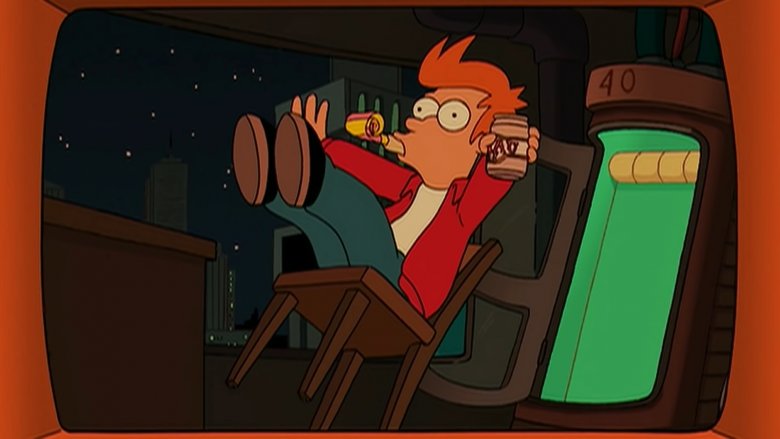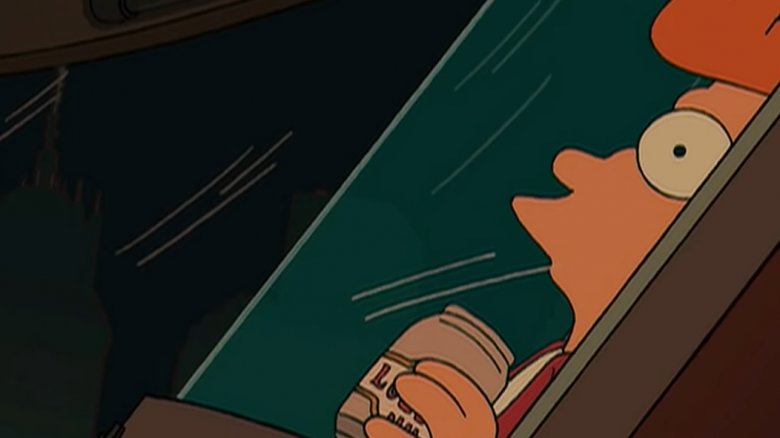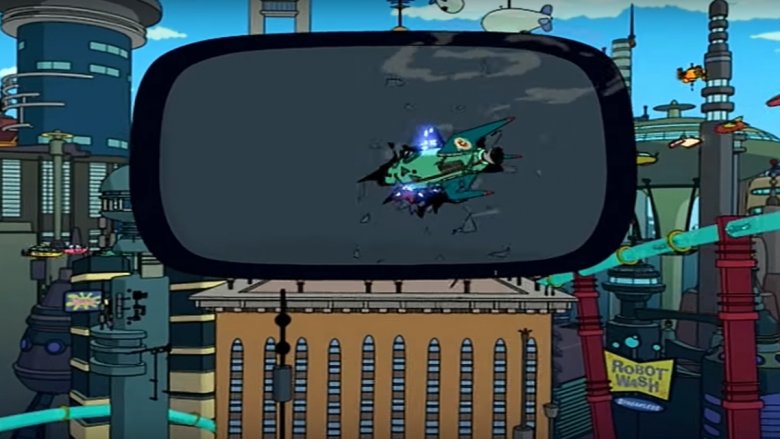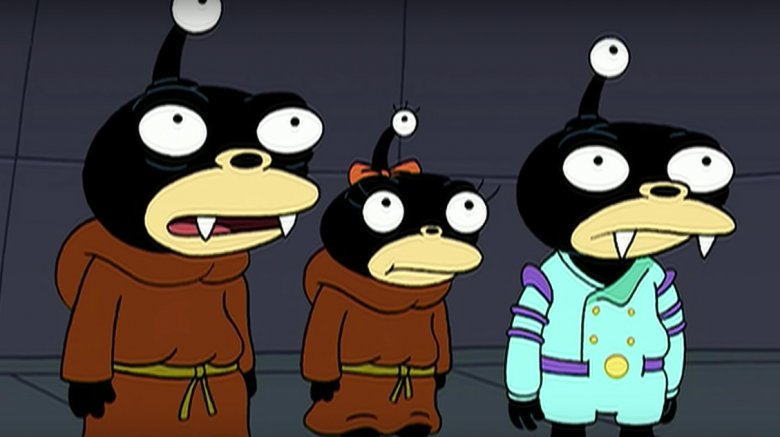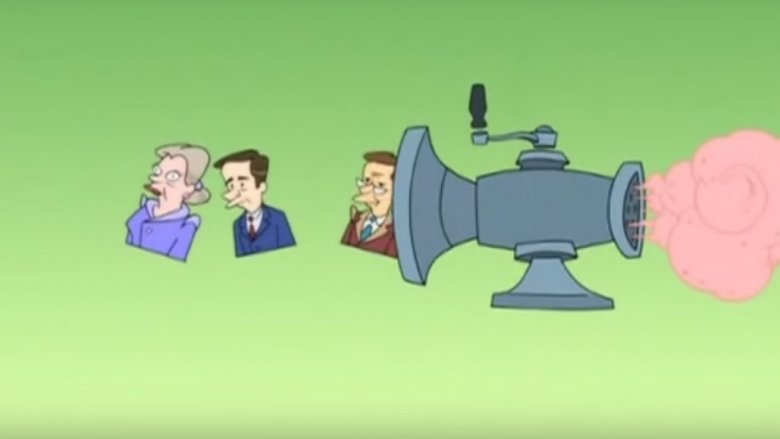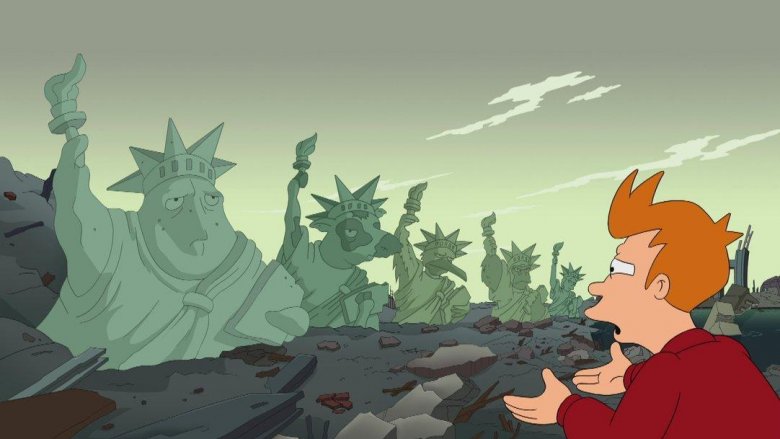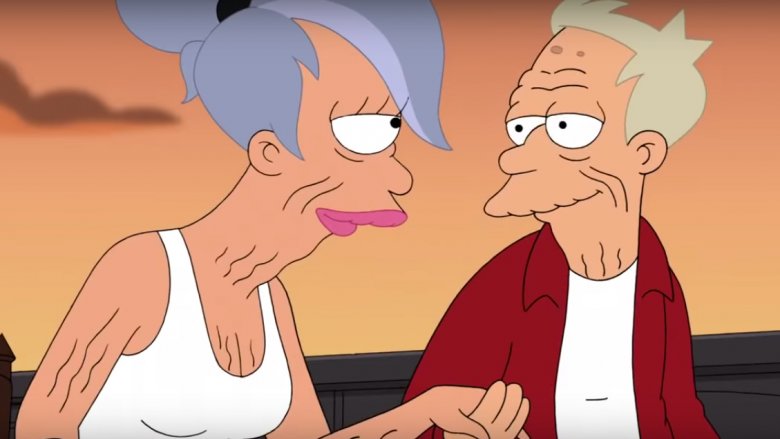The Entire Futurama Timeline Finally Explained
Futurama debuted more than two decades ago, and what started out as the ugly step-sibling to the Great Undying One known as The Simpsons slowly developed a cult following. It became a fast-paced pop culture haven that managed to speak to nerds without talking down to them.
Over the course of seven seasons, four TV movies, six Emmys, and one ill-conceived cancellation, Futurama created a sardonic, clever universe filled with unique characters and the occasional sucker punch to the feels (you were a good boy, Seymour.) At its surface, yes, it was the story of an idiot delivery boy, cryogenically displaced to the 31st century. But a quick glance under its technicolor exterior reveals a shockingly deep world, rich with history, cutting satire, and at least one functioning alien language that got added as a goof. If that kind of effort went into just sort of being dorks, imagine the amount of thought the writers put into the twisty timeline itself.
Or don't imagine. We'll take you through it. Good news, everyone. Here, now, presented in Hypno-Vision, is the Futurama timeline, served up in one easily digestible serving like so much nutritious Slurm.
In the beginning of Futurama
The Big Bang. There's something comforting about the idea that the universe has a definable start date, a point on the timeline that you can circle with a red marker and go, "That's where things kicked off," soothing the overwhelming sensation of infinite existence by anchoring your sense of reality to a finite point.
So let's abandon that feeling of security and look at what happened before the beginning. Long before everything that has ever existed got on with the business of expanding out into the unceasing void, there was Yivo, the planet-sized tentacle beast from another universe who preferred "shklee" and "shkler" pronouns, thank you very much. Since nobody else was around yet, there's not a lot to report on shkler activities. There may have been a stamp collection. In any case, you can understand how shklee got so lonesome. More on that later.
There was this other thing. About 17 years before the Big Bang, Nibblonians started to pop up. Yes, Nibblonians are older and perhaps more complex than the universe itself and, on an unrelated note, just as cute as a button.
Futurama introduces the Nibblonian/Brain Spawn War
The Big Bang was sort of a busy day for the universe. For one thing, it started existing, which is always a mixed bag.
Then, fractions of a moment after all of being started doing its thing, there was the genesis of the Brain Spawn, a species of floating brains with a penchant for destroying sentient thought and the planets where it could be found. The Brain Spawn immediately clashed with the noble Nibblonians, and the Nibblonian/Brain Spawn War was underway. Fighting between the two races would continue across the cosmos for the next several billion years.
On a physically smaller but equally important scale, around this time, a small time ship appeared, carrying Fry, Bender, and the Professor from a previous incarnation of the universe. The travelers would only make a brief pit stop at the beginning of time before carrying on their merry way through the Möbius strip of reality, but we're getting ahead of ourselves again.
Onward, through time
Between the beginning of everything and the time the first Matrix movie came out, a decent nugget of existence took place.
To summarize, the Brain Spawn, negative nellies that they were, wiped out dinosaurs from the planet Earth. Mankind, maybe not thinking clearly, evolved, forming societies and cultures and generating all of our species' history. Around 3500 BC, cat aliens popped up in Egypt and had folks build them some pyramids.
Other aliens visited the planet from time to time. During the 16th century, an extraterrestrial named Leonardo from the planet Vinci visited and propelled human science forward. The Nibblonians continued their surreptitious activities. In the 1700s, we got our first mention of the Fry lineage with Minuteman Yancy Fry, a Yankee soldier who fought for American independence. At around the same time, a time-travelling Fry, Leela, Professor Farnsworth and Bender stopped a colonial era counterfeiter named David Farnsworth who, and this is kind of cool, actually existed.
Jumping forward a little more than a century, Fry and the rest of the Planet Express crew flew to the 1940s where Fry got his grandma pregnant and became his own grandfather. As a result of this, 30 years later, Fry was born. In the '90s, he met a stray dog named Seymour Asses and, as a direct result of that, adult audiences across the country found themselves weeping openly at a primetime cartoon show.
Futurama, Fry, and cryogenic chambers
Fry lived an unexceptional life punctuated by madcap skullduggery. He dropped out of community college, found an extra lucky seven-leaf clover, and accidentally cut the signal to the hit show Single Female Lawyer before it could be broadcast into space, inadvertently setting into motion a near end-of-the-world invasion a thousand years later.
Then came the turn of a new millennium and a pizza order several billion years in the making.
On New Year's Eve, 1999, pizza delivery boy Philip J. Fry received an order to be delivered to one "I.C. Wiener" at Applied Cryogenics in New York City. He could little expect that the prank delivery was actually a ruse set up by ancient hyper-intelligent aliens and himself from the future, culminating in the eventual salvation of the known universe and revolving around Fry being frozen in a cryogenic chamber for the next ten centuries.
A few moments after Fry was deep chilled, another Fry from the 31st century also arrived, but he wound up becoming a time paradox, sacrificing himself during Bender's Big Score and generally bumming everyone out.
The good cold days
The thousand years between Fry's initial freezing and his thaw in the year 3000 were busy, and not everything is clear, but here's what we know.
The human race was enslaved at least once, by a race of giant carrots, as mentioned in the episode "Future Stock." Some time later, the Decapodians (aka the Zoidbergs) made their way to Earth, almost immediately eating every anchovy in existence. Star Trek and its lead actors became so popular that world leaders banned it for fear of losing political power. At some point, as shown in the time lapse in the pilot episode, a more primitive medieval society arose on Earth, only to be wiped away by time's terrible dance.
The robots of today slowly turned into the robots of the future, developing personalities and aspirations and alcohol dependencies. Mars was colonized, the moon was overrun by hillbillies, New New York was built on top of New York, which became the go-to spot for radioactive waste and the subterranean mutants it created. Robot Santa Claus came online in 2801 and began his annual tradition of reigning down terror on the people of Earth.
Most importantly, though? Some time late in the 30th century, the hit network sitcom Everybody Loves Hypnotoad was broadcast for the first time, though most critics agree that it was severely lacking in quALL GLORY TO HYPNOTOAD.
Into the future
In the waning hours of December 31, 2999, Philip J. Fry found himself unfrozen and thrust into a world far removed from his own. There, he met a cyclops named Leela, a distant descendant named Professor Hubert J. Farnsworth, and one Bender Bending Rodriguez, a suicidal bending robot. Fry, Leela, and Bender got jobs working for the Professor's interstellar delivery company, Planet Express, thanks to the untimely deaths of his previous employees.
Over the next year, a whole lot of first season worldbuilding went on. A giant ball of garbage that had rocketed into space in the mid-21st century returned to Earth. Speaking of big balls of garbage, Richard Nixon's head was elected president of Earth, along with his vice president, the decapitated body of Spiro Agnew. The Planet Express crew proved they were worth their salt in December when they held the annual onslaught of Robot Santa at bay. The Omicronians invaded, which became sort of a pattern of behavior with them. Fry and Leela, in keeping with a long and noble episodic television tradition, will-theyed and won't-theyed, setting up a precedent for a lot of the rest of the show.
Further into the future (and sometimes the past)
Luckily, from this point forward, the progression of time kept roughly the same pace as the events of the show, with each season representing the events of a calendar year, give or take, and not including time travel, which happened a lot.
By way of example, in 3001, the Professor de-tanked his lovable young clone, Hubert. The crew discovered the sunken city of Atlanta, Georgia. Pauly Shore was, woefully, unfrozen from cryosleep. Mom made her first all-out grab at world domination when she programmed all of Earth's robots to seize dominion of the planet in her name on Mother's Day.
As the years pressed on, more hijinks ensued. Fry and Leela continued to brush up against romance. Fry and the Nibblonians beat back an attack by the Brain Spawn in 3002. Another Omicronian invasion took place in 3002, then the Decapodians took a crack at it in 3003. The year after that, Fry and Lord Nibbler won a final and decisive victory against the Brain Spawn by trapping them in an alternate dimension, ending a war that had been going on since the Big Bang.
The darkness, Lars, and the return of Yivo
If you were around and watching the show back before network television was beaten bloody by direct streaming services, you'll remember that this was about the point where Futurama underwent a brief, ill-conceived cancellation before being revived with four direct-to-video movies. Within the series, the two year blackout was explained like this. In 3005, the Planet Express crew was fired by a group of bumbling (ahem) Box Network executives, who were then killed and ground into a multi-purpose dust suitable for applications as varied as feeding heads in jars and powdering one's butt. With the "brainless drones" out of the way, the crew returned to the skies and resumed their adventures.
In 3007, Fry, heartbroken, decided to return to the year 2000 to live out his old life. This created a time double who spent some time back in the 21st century before returning, now hairless and with a raspy voice, to the future, assuming the name Lars Fillmore and finally wooing Leela. Lars would then sacrifice himself to save Leela.
The next year, Yivo, the lonesome planet entity from before the Big Bang, managed to find shkler way to Earth thanks to a tear in space and time caused by all of the Planet Express gang's shenanigans. Yivo briefly dated all of humankind before realizing that we're kind of a mess and leaving the way shklee came in.
Forward, into the past
The adventures of the Planet Express crew continued on, and frankly, 140 episodes is a lot to try and summarize in one go, so from here, we'll bounce straight to our next glimpse of the show's universe, as witnessed in the episode "The Late Philip J. Fry."
The story goes like this. In the year 3010, Professor Farnsworth invented a forward time machine, capable of propelling its occupants through time, but only forward. Fry, Bender, and the Professor, through miscalculations and some accidental lever pushing, wound up travelling to the end of the universe. Here's what they discovered.
By the year 10,000, as evidenced by a beach lined with Planet of the Apes twist endings, Earth had been home to at least five species advanced enough to create their own Statues of Liberty: humans, apes, birds, cows, and some sort of blob things.
In the year 5 million, two species inhabited Earth, one above ground and one below, H.G. Welles-style. Five years later, the savage subterranean creatures had slaughtered the denizens of the surface.
In 10 million A.D., robots had hunted down most of humanity. In the year 50 million, Earth had been repopulated by beautiful geniuses. On and on the company continued forward, eventually reaching the end of the universe where, much to everyone's surprise, everything just sort of started over again. And after accidentally landing their time ship on top of this new timeline's Fry, Bender, and Professor, they resumed life as usual.
Futurama gets loopier and loopier
In the year 3013 (and, for anyone keeping score at home, the series finale), Fry finally decided to propose to Leela. What might've been a touching yet run-of-the-mill to-do wound up tangled in textbook Futurama weirdness. There was sci-fi, there was the threat of suicide, and of course, there was the manipulation of the flow of time.
The long and short of it is this. As the result of an accident involving the Professor's new invention, the time button, Fry and Leela wound up freezing time for everyone but themselves. Together, the two embarked on a surreal life together, exploring the world with everyone and everything else paralyzed around them. They grew old, held hands, and just when you thought that you weren't going to weep at any more cartoons ever again, they ran into the Professor, who tunneled through the time stream to find them and the time button, which he then repaired. The Professor then offered to repair the time stream, sending all of them back to the beginning. A happy Fry and Leela decided to go do the whole thing over again.
The long term effects were as follows. Firstly, Futurama closed its own time loop, making it technically the first infinitely rewatchable show in history. Second, we all realized that we'd never find love as perfect as the one shared by the cyclops and the redhead on TV, so we went back to watching game shows instead.
